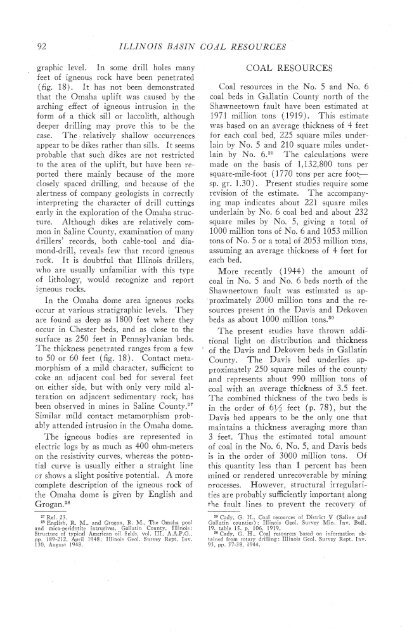subsurface geology and coal resources of the pennsylvanian system ...
subsurface geology and coal resources of the pennsylvanian system ...
subsurface geology and coal resources of the pennsylvanian system ...
You also want an ePaper? Increase the reach of your titles
YUMPU automatically turns print PDFs into web optimized ePapers that Google loves.
92 ILLINOIS BASIN COAL RESOURCES<br />
graphic level. In some drill holes many<br />
feet <strong>of</strong> igneous rock have been peneti-ated<br />
(fig. 18). It has not been demonstrated<br />
that <strong>the</strong> Omaha uplift was caused by <strong>the</strong><br />
arching effect od igneous intrusion in <strong>the</strong><br />
form <strong>of</strong> a thick sill or laccolith, although<br />
deeper drilling may prove this to be <strong>the</strong><br />
case. The relatively shallow occurrences<br />
appear to be dikes ra<strong>the</strong>r than sills. It seems<br />
probable that such dikes are not restricted<br />
to <strong>the</strong> area <strong>of</strong> <strong>the</strong> uplift, but have been reported<br />
<strong>the</strong>re mainly because <strong>of</strong> <strong>the</strong> more<br />
closely spaced drilling, <strong>and</strong> because <strong>of</strong> <strong>the</strong><br />
alertness <strong>of</strong> company geologists in correctly<br />
interpreting <strong>the</strong> character <strong>of</strong> drill cuttings<br />
early in <strong>the</strong> exploration <strong>of</strong> <strong>the</strong> Omaha structure.<br />
Although dikes are relatively common<br />
in Saline County, examination <strong>of</strong> many<br />
drillers' records, both cable-tool <strong>and</strong> diamond-drill,<br />
reveals few that record igneous<br />
rock. It is doubtful that Illinois drillers,<br />
who are usually unfamiliar with this type<br />
<strong>of</strong> lithology, would recognize <strong>and</strong> report<br />
i~neous rocks.<br />
In <strong>the</strong> Omaha dome area igneous rocks<br />
occur at various stratigraphic levels. They<br />
are found as deep as 1800 feet where <strong>the</strong>y<br />
occur in Chester beds, <strong>and</strong> as close to <strong>the</strong><br />
surface as 250 feet in Pennsylvanian beds.<br />
The thickness penetrated ranges from a few<br />
to 50 or 60 feet (fig. IS). Contact metamorphism<br />
<strong>of</strong> a mild character, sufficient to<br />
coke an adjacent <strong>coal</strong> bed for several feet<br />
on ei<strong>the</strong>r side, but with only very mild alteration<br />
on adjacent sedimentary rock, has<br />
been observed in mines in Saline C~unty.'~<br />
Similar mild contact metamorphism probably<br />
attended intrusion in <strong>the</strong> Omaha dome.<br />
The igneous bodies are represented in<br />
electric logs by as much as 400 ohm-meters<br />
on <strong>the</strong> sesistivity curves, whereas <strong>the</strong> potential<br />
curve is usually ei<strong>the</strong>r a straight line<br />
Gr sho,~vs a slight positive potential. A more<br />
complete description <strong>of</strong> <strong>the</strong> igneous rock <strong>of</strong><br />
<strong>the</strong> Omaha dome is given by English <strong>and</strong><br />
G~ogan.~'<br />
2i Ref. 23.<br />
2s English, R. M.. <strong>and</strong> Grogan, R. M., The Omaha pool<br />
<strong>and</strong> mica-peridotite intrusives. Gnllntin County, Illinois:<br />
Structure <strong>of</strong> typical American. oil fields. vol. 111, A.A.P.G.,<br />
pp. 189-212. April 1948; Illino~s Geol. Survey Rept. Inv.<br />
130, Allgust 1948.<br />
GOAL RESOURCES<br />
Coal <strong>resources</strong> in <strong>the</strong> No. 5 <strong>and</strong> No. 6<br />
<strong>coal</strong> beds in Gallatin County north <strong>of</strong> <strong>the</strong><br />
Shawneeto~vn fault have been estimated at<br />
1971 million tons (1919). This estimate<br />
was based on an average thickness <strong>of</strong> 4 feet<br />
for each <strong>coal</strong> bed, 225 square miles underlain<br />
by No. 5 <strong>and</strong> 210 square miles underlain<br />
by No. 6.2The calculations were<br />
made on <strong>the</strong> basis <strong>of</strong> 1,132,800 tons per<br />
square-mile-foot (1770 tons per acre footsp.<br />
gr. 1.30). Present studies require some<br />
revision <strong>of</strong> <strong>the</strong> estimate. The accompanying<br />
map indicates about 221 square miles<br />
underlain by No. 6 <strong>coal</strong> bed <strong>and</strong> about 232<br />
square miles by No. 5, giving a total <strong>of</strong><br />
1000 million tons o,f No. 6 <strong>and</strong> 1053 million<br />
tons <strong>of</strong> No. 5 or a total <strong>of</strong> 2053 million tons,<br />
assuming an average thickness <strong>of</strong> 4 feet for<br />
each bed.<br />
More recently (1944) <strong>the</strong> amount <strong>of</strong><br />
<strong>coal</strong> in No. 5 <strong>and</strong> NO. 6 beds north <strong>of</strong> <strong>the</strong><br />
§hawneetown fault was estimated as approximately<br />
2000 million tons <strong>and</strong> <strong>the</strong> <strong>resources</strong><br />
present in <strong>the</strong> Davis <strong>and</strong> Dekoven<br />
beds as about 1000 million tons.30<br />
The present studies have thrown additional<br />
light on distribution <strong>and</strong> thickness<br />
<strong>of</strong> <strong>the</strong> Davis <strong>and</strong> Dekoven beds in Gallatin<br />
County. The Davis bed underlies approximately<br />
250 square miles <strong>of</strong> <strong>the</strong> county<br />
<strong>and</strong> represents about 990 million tons <strong>of</strong><br />
<strong>coal</strong> with an average thickness <strong>of</strong> 3.5 feet.<br />
The combined thickness <strong>of</strong> <strong>the</strong> two beds is<br />
in <strong>the</strong> order <strong>of</strong> 6s feet (p. 78), but <strong>the</strong><br />
Davis bed appears to be <strong>the</strong> only one that<br />
maintains a thickness averaging more than<br />
3 feet. Thus <strong>the</strong> estimated total amount<br />
<strong>of</strong> <strong>coal</strong> in <strong>the</strong> No. 6, No. 5, <strong>and</strong> Davis beds<br />
is in <strong>the</strong> order <strong>of</strong> 3000 million tons. Of<br />
this quantity less than 1 percent has been<br />
mined or rendered unrecoverable by mining<br />
mocesses. However, structural irregularities<br />
are probably sufficiently important along<br />
<strong>the</strong> fp-ult lines to prevent <strong>the</strong> recovery <strong>of</strong><br />
2Tady, G. H.. Coal <strong>resources</strong> <strong>of</strong> District V (Saline <strong>and</strong><br />
Gallatin counties) : Illinois Geol. Survey Min. Inv. Bull.<br />
19. table 15. p. 106, 1919.<br />
30 Cady, G. H.. Coal <strong>resources</strong> based on information obtained<br />
from rotary drilling: Illinois Geol. Survey Rept. Inv.<br />
93, pp. 37-38. 1944.
















